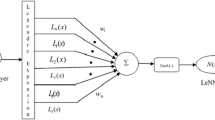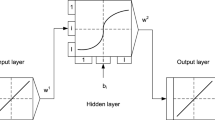Abstract
The authors have developed an efficient method with the Fibonacci neural network’s help to solve the fractional-order reaction-diffusion equation in the present article. The Fibonacci neural network consists of an input layer with one perceptron, a hidden layer with \(n\times m\) perceptions, and an output layer with one perceptron. The authors have used various degrees of the Fibonacci polynomial as an activation function to the input in the hidden layer. The authors then convert the fractional order diffusion equation with initial and boundary conditions into a non-constrained optimization problem, which is then called the cost function. Marquardt’s method is used to update the values of weights to minimize the cost function. After that, the authors used the discussed method on four examples with an exact solution and showed that our method works more accurately than previously existing methods through comparison. In the last, authors have used the discussed method to solve the unsolved diffusion equation and observe the change in solute concentration for different fractional-order at different times.








Similar content being viewed by others
References
Berg J, Nyström K (2018) A unified deep artificial neural network approach to partial differential equations in complex geometries. Neurocomputing 317:28–41
Berner J, Grohs P, Jentzen A (2018) Analysis of the generalization error: Empirical risk minimization over deep artificial neural networks overcomes the curse of dimensionality in the numerical approximation of black-scholes partial differential equations. arXiv preprint arXiv:1809.03062
Ghandehari MAM, Ranjbar M (2013) A numerical method for solving a fractional partial differential equation through converting it into an nlp problem. Comput Math Appl 65(7):975–982
Ghasemi S, Effati S (2019) An artificial neural network for solving distributed optimal control of the poisson’s equation. Neural Process Lett 49(1):159–175
Lundstrom BN, Higgs MH, Spain WJ, Fairhall AL (2008) Fractional differentiation by neocortical pyramidal neurons. Nat Neurosci 11(11):1335
Mall S, Chakraverty S (2017) Single layer chebyshev neural network model for solving elliptic partial differential equations. Neural Process Lett 45(3):825–840
Metzler R, Klafter J (2004) The restaurant at the end of the random walk: recent developments in the description of anomalous transport by fractional dynamics. J Phys A Math General 37(31):R161
Momani S, Yıldırım A (2010) Analytical approximate solutions of the fractional convection-diffusion equation with nonlinear source term by he’s homotopy perturbation method. Int J Comput Math 87(5):1057–1065
Pagnini G (2011) Nonlinear time-fractional differential equations in combustion science. Fract Calculus Appl Anal 14(1):80–93
Podlubny I (1998) Fractional differential equations: an introduction to fractional derivatives, fractional differential equations, to methods of their solution and some of their applications. Elsevier, New York
Raissi M (2018) Forward-backward stochastic neural networks: Deep learning of high-dimensional partial differential equations. arXiv preprint arXiv:1804.07010
Ravindran A, Reklaitis GV, Ragsdell KM (2006) Engineering optimization: methods and applications. Wiley, London
Rudd K, Ferrari S (2015) A constrained integration (cint) approach to solving partial differential equations using artificial neural networks. Neurocomputing 155:277–285
Saadatmandi A, Dehghan M (2011) A tau approach for solution of the space fractional diffusion equation. Comput Math Appl 62(3):1135–1142
Scalas E (2006) The application of continuous-time random walks in finance and economics. Phys A Stat Mech Appl 362(2):225–239
Sun H, Hou M, Yang Y, Zhang T, Weng F, Han F (2019) Solving partial differential equation based on bernstein neural network and extreme learning machine algorithm. Neural Process Lett 50(2):1153–1172
Sweilam N, Nagy A, El-Sayed AA (2015) Second kind shifted chebyshev polynomials for solving space fractional order diffusion equation. Chaos Solit Fract 73:141–147
Sweilam N, Nagy A, El-Sayed AA (2016) On the numerical solution of space fractional order diffusion equation via shifted chebyshev polynomials of the third kind. J King Saud Univ Sci 28(1):41–47
Tadjeran C, Meerschaert MM, Scheffler HP (2006) A second-order accurate numerical approximation for the fractional diffusion equation. J Comput Phys 213(1):205–213
Tawfiq LNM, Salih OM (2019) Design neural network based upon decomposition approach for solving reaction diffusion equation. In: Journal of Physics: Conference Series, vol. 1234, p. 012104. IOP Publishing
Uddin M, Haq S (2011) Rbfs approximation method for time fractional partial differential equations. Commun Nonlinear Sci Numer Simul 16(11):4208–4214
Vinagre B, Podlubny I, Hernandez A, Feliu V (2000) Some approximations of fractional order operators used in control theory and applications. Fract Calcul Appl Anal 3(3):231–248
Yang Y, Hou M, Sun H, Zhang T, Weng F, Luo J (2020) Neural network algorithm based on legendre improved extreme learning machine for solving elliptic partial differential equations. Soft Comput 24(2):1083–1096
Author information
Authors and Affiliations
Corresponding author
Ethics declarations
Conflicts of interest
We have no conflict of interest to declare.
Additional information
Publisher's Note
Springer Nature remains neutral with regard to jurisdictional claims in published maps and institutional affiliations.
Rights and permissions
About this article
Cite this article
Dwivedi, K.D., Rajeev Numerical Solution of Fractional Order Advection Reaction Diffusion Equation with Fibonacci Neural Network. Neural Process Lett 53, 2687–2699 (2021). https://doi.org/10.1007/s11063-021-10513-x
Accepted:
Published:
Issue Date:
DOI: https://doi.org/10.1007/s11063-021-10513-x




